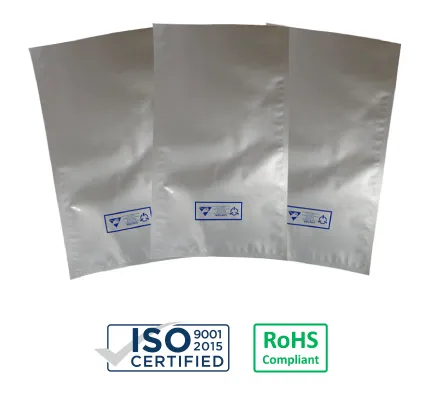Aluminum Foil Vacuum Bag

Material Composition:
ESD/PET/AL/ONY/LDPE/ESD
Product Description:
The bag is made of multi-layer laminated materials, offering excellent moisture and air barrier properties. It has good puncture resistance and high tensile strength, which helps extend the product’s shelf life while meeting customer packaging aesthetics requirements.
Electrostatic Protection:1×108~9.99×1011Q/sq(static dissipation time < 2 seconds)
Moisture Barrier:<0.01g/m² ·day , Gas Barrier:<0.1c.c./m² ·day
Electromagnetic Interference:EMI Shielding Effective >40dB、EMI Shielding Rate >99.99%。
Application Scope:
IC packaging, wafer cassettes, tape reels, reticle boxes, printed circuit boards (PCBs), motherboards, memory modules (RAM), electrostatic protective packaging for panels, electrostatic vacuum packaging for passive components, optical materials, precision electronic component packaging, etc.
Electrostatic Discharge:
In nature, materials can gain or lose electrons through certain processes (such as friction or induction), and the resulting charges are referred to as static electricity. When positive or negative charges accumulate, they create a potential difference with the surrounding environment. If these charges transfer between regions of different potential via a discharge path, this phenomenon is known as Electrostatic Discharge (ESD).
ESD is a major cause of electrical overstress (EOS) that damages most electronic components or systems. This type of damage can lead to permanent failures in semiconductor devices and computer systems, impairing the functionality of integrated circuits (ICs) and causing malfunctions in electronic products.
The occurrence of ESD damage is often the result of human factors, though it is difficult to completely avoid. During the manufacturing, production, assembly, testing, storage, and transportation processes, static electricity can accumulate on the human body, equipment, storage devices, and even on the electronic components themselves. Unknowingly, when these objects come into contact with one another, they form a discharge path, exposing the electronic components or systems to the destructive effects of ESD.
Principle of Anti-Static Packaging:
The working principle of anti-static bags is based on the use of conductive materials to disperse and absorb static charges. The basic steps of how anti-static bags work are as follows::
。Conductive Materials: Anti-static bags typically contain a layer of conductive material, such as metal foil or anti-static coatings. These conductive materials allow static charges to be transferred to the outer surface of the bag.
。Insulating Layer: On the exterior of the conductive layer, the anti-static bag also includes an insulating layer, usually made of plastic, to isolate the internal items from the external static effects.
。Sealing: Anti-static bags often feature a resealable zipper or sealing strip to ensure that the interior space is completely enclosed, preventing the ingress of static charges.
。Sealing: Anti-static bags often feature a resealable zipper or sealing strip to ensure that the interior space is completely enclosed, preventing the ingress of static charges.





